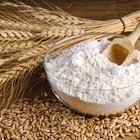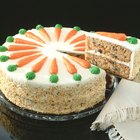gm-photo/iStock/GettyImages
Baking with whole-wheat flour doesn’t always mean the results have to be heavy and dense. Whole-wheat pastry flour milled from finely ground soft wheat has a much lower protein content than all-purpose flour, making it ideal for cake baking where a tender crumb is desired. Substitution amounts for unbleached flour depend on the kind of cake you are baking and the results you are hoping to achieve.
Considering the Protein
The kind of wheat -- hard or soft -- and how it is processed yield different protein levels in the flour. Protein is what allows flour to develop gluten, a good thing when you are making structured yeast bread, but not so good when you are making cake. For deserts made with sugar where a moist, melt-in-your-mouth texture is desired, choose a low-protein flour. Cake flour developed specifically for making tender cakes has a low protein content between 8 and 10 percent per cup, the same as pastry flour. All-purpose, unbleached flour contains between 11 and 12 percent of protein per cup.
Considering the Cake
In many cases, whole-wheat pastry flour can be substituted in equal measure for all-purpose unbleached flour with positive results. In other instances, it’s best to substitute only half the amount of unbleached flour for whole-wheat pastry flour. The difference depends on the kind of cake you are baking. Although whole-wheat pastry flour is light and finely ground, it is made from whole wheat, which does affect the taste of the flour. Substitute whole-wheat pastry flour in equal measure for unbleached flour in recipes where its earthy flavor is complemented by the kind of cake.
Making the Substitution
For spice cakes, carrot cake and other oil and butter cakes made with fruits and nuts, the taste of whole-wheat pastry flour makes for a compatible, equal substitution for unbleached flour. For best results when making light sponge and delicate foam cakes, substitute no more than 50 percent of the unbleached flour with whole-wheat pastry flour. For other oil and butter cakes, such as those served with rich chocolate frostings or fillings, the choice of whether to cut the sweetness with the taste of wheat is up to you.
Comparing Whole Wheat
Whole-wheat flour differs from whole-wheat pastry flour in two ways: whole-wheat flour is made from hard wheat, and its protein content is considered high at 14 percent. It cannot be substituted in equal measure for unbleached flour because it is heavier and contains more protein. It’s best used for bread making where a chewy texture and structure is desired, in which case it should make up no more than 50 percent of the flour. Using whole-wheat pastry flour instead of whole-wheat flour when making baked goods will solve the problem of heaviness while still providing the goodness of whole grain.
Bleached or Unbleached
Unbleached flour is aged naturally through prolonged exposure to oxygen, and has a vanilla color. In cake baking, its performance is not as consistent as bleached flour, which offers slightly less protein. When flour is bleached, chemicals are added to speed up the aging process, resulting in a brighter flour that matures more quickly, desirable for making snowy white cakes. The chemical residues are washed away, and no change is made to the nutritional value of the flour. It’s worth noting that unbleached flour may still contain maturing agents and chemical dough improvers, but those ingredients will be listed on the label.
Related Articles

What Kind of Oil Do You Use in Brownie ...

Bread Flour vs. Cake Flour in Sponge ...
Is Unbleached Flour the Same as ...

What Kind of Flour to Use for Cupcakes?
Does Cake Flour Contain Baking Soda & ...

Differences Between Bleached Flour & ...
What Is the Difference Between Cake ...

Do You Still Need Baking Powder & Salt ...
What Kind of Flour Do You Use for a ...

Can You Substitute Whole Wheat Pastry ...
Flour Substitute for Muffins

Can I Substitute Bleached for ...

What Is a Substitute for Potassium ...

Whole Wheat Pastry: Flour Substitutions
Cooking With Wheat Vs. White Flour

What Are Good Substitutes for Vegetable ...
What Frosting Goes Well With Angel Food ...

What Are the Functions of Flour in ...

How Do Different Types of Flour Affect ...

What Does Adding Applesauce to Cake Mix ...
References
Resources
Writer Bio
For more than 10 years, Carol Butler has run a small, off-grid furniture business with her husband and is a regular contributor to the Edible community of magazines. As staff writer for RichLife Advisors, she covers financial planning and other industry-related topics. She holds a B.F.A. in theater arts.